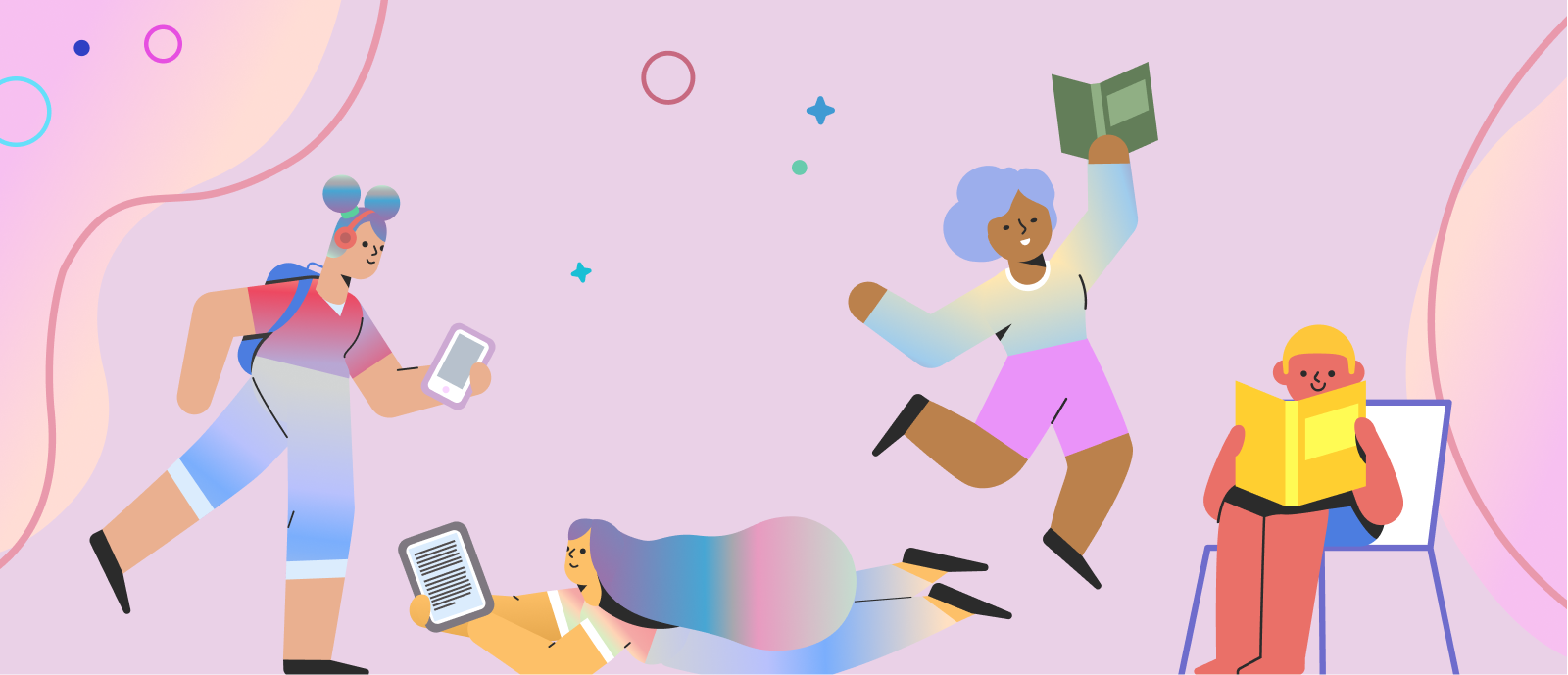The United States is currently facing a significant literacy crisis, with approximately 45 million Americans struggling with functional illiteracy. According to the National Literacy Institute, up to 20% of Americans read below the level required to secure a living wage. These statistics directly impact the economy and highlight the urgent need to prioritize literacy in schools and communities. Here’s a closer look at literacy and how Beanstack can support schools and libraries in building literate communities.
What Is Literacy?
The National Center for Education Statistics defines literacy as “the ability to use printed and written information to function in society, to achieve one’s goals, and to develop one’s knowledge and potential.” Literacy develops in childhood but extends well into adulthood, making it one of the most important skills learned in school.
What Is the Difference Between Reading and Literacy?
When discussing the difference between literacy and reading, it’s clear that they are interrelated. One of the crucial components of literacy is reading. Reading involves decoding symbols that create words so people can understand the meaning of written passages and read for pleasure or information.
However, while people must be able to read to be literate, literacy includes using written words to communicate and function in society. Simply being able to read isn’t enough. Literacy takes it a step further to use those skills to navigate the world. Reading signs, interpreting bills, and writing emails all involve literacy.

7 Benefits of Improving Literacy Skills
As the nation faces challenges in literacy, educators are exploring solutions to improve student literacy and overall student outcomes. The benefits of these initiatives include the following:
1. Expanded Vocabulary
Introducing students to multiple literary techniques allows them to learn and understand how to use new words. Expanded vocabulary, in turn, improves their communication skills. From listening and speaking to reading and writing, vocabulary is essential to a student’s success—and vocabulary expansion directly influences academic accomplishments.
2. Advanced Writing Skills
Literacy involves reading and writing; advanced writing skills help improve memory and language development. Students who are proficient writers are also typically adept readers, showcasing a valuable form of communication highly sought after by employers. Effective communication—spanning written, verbal, nonverbal, and visual mediums—is a desirable skill for people looking to hire.
3. Increased Empathy
Reading and literacy both help build empathy. Students are exposed to differing viewpoints and ideas and learn to appreciate different lifestyles and ideals. Students who show empathy work well with others in class, build strong connections with their teachers, and actively participate in school. Those with a higher level of empathy often achieve better grades and ultimately experience more success in college.
4. Cognitive Development
As students move through language development and learn to think and respond to what they read, they build critical thinking skills. This literacy component involves making informed decisions and solving complex problems—a daily skill. Students can evaluate the accuracy and trustworthiness of information in written and spoken forms by critically analyzing a topic and breaking it down into its essential elements.
5. Greater Concentration
Students who enjoy reading can focus for extended periods, enhancing their reading speed and allowing them to gain valuable study skills for the future. Improved focus leads to better retention of information and higher student engagement, which is vital for increased understanding, learning, and growth.
6. Improved Academic Outcomes
Multiple studies have linked literacy to improved academic outcomes for students. Students will do better academically when they read, develop language and writing skills, grow their critical thinking, and improve their concentration.
7. Strengthened Communities
Literacy offers many benefits to adults in addition to children. According to Literacy Pittsburgh, literacy brings several benefits to overall communities, including:
- Better effectiveness in the workplace
- Improved job opportunities
- Improved workforce skill levels
- Stronger economies
- Greater overall productivity
These advantages present exciting opportunities for schools and communities to pursue, but they require the right resources. Having discussed literacy’s benefits, let’s delve into practical strategies to address the nation’s literacy challenges. Read on to gain a deeper insight into literacy development at school and community levels.
How to Improve Literacy in the Classroom
Addressing literacy is a complex and multifaceted challenge, with the classroom being a crucial starting point. To enhance literacy skills among students, it’s essential to develop and execute effective literacy strategies within the school environment.
What Are Literacy Strategies?
Literacy strategies are the techniques educators use to help students increase their reading and writing abilities. These strategies include spelling, analyzing and comprehending text, and articulating spoken and written language.
Top Literacy Strategies and Guiding Principles
What literacy strategies can teachers use in today’s classroom? Examples of strategies and guiding principles include:
- Annotating the Text: Highlighting, circling, and adding notes to the text while reading can lead to better comprehension.
- Book Recommendations: Adding recommended reading lists can encourage students to try new genres, authors, and literature types. It also allows teachers and other mentors to highlight what they like to read.
- Self-Choice in Reading: Allowing students to select reading materials helps boost literacy and encourage excitement about reading.
- Graphic Organizers: A simple tool that allows kids to break down stories and nonfiction texts by creating an outline of their reading—an excellent method for visual learners.
- Rewards for Reading: Rewarding students for reading creates intrinsic motivation to continue reading.
- A Culture of Reading: In both the classroom and the larger school community, creating a culture of reading, talking about reading, and getting students excited to read boosts literacy.
- Compelling Libraries: An organized and diverse classroom library keeps books within easy reach and encourages independent reading time.
How to Improve Literacy Outside of the Classroom
Expanding learning beyond the classroom is essential to boost literacy levels further. Parents and caregivers play a crucial role in their child’s literacy journey. For younger children, nursery rhymes, singing, and read-aloud sessions are helpful for language and early literacy development. Kids of all ages can benefit from observing adults engrossed in reading daily; bonding over shared activities with your children strengthens your connection.
A great place to find support for building literacy is your local library. Libraries provide communities with fun programming for kids, including reading challenges, summer reading programs, book clubs, and author meetups.
How Beanstack Supports Literacy
The challenge of literacy among students is widespread and complex. By focusing on solutions, educators and parents together can tackle it head-on. The right tools can boost literacy and excite kids about reading—and Beanstack is one of these tools.
With Beanstack, students read more and develop consistent reading habits using a fun, gamified platform. By encouraging connections between families, teachers, and community members, all work together to achieve reading goals. It also assists readers of all ages through local libraries and community programs in becoming better readers. With adults and children alike, Beanstack is fun and engaging, making it work as a tool to support increased literacy in both the classroom and the community.
In the Classroom
Beanstack engages students to make reading fun, personalized, and rewarding. The platform does this in several ways:
Community Reading Challenges
Literacy skills improve the more students read. Beanstack reading challenges encourage students to read independently and provide a way for them to connect with their peers. Our research has found that schools with a school-wide goal log 46% more reading minutes than those who do not set a community goal for their reading challenges. In addition, three out of every four students read seven days in a row or more. Since Beanstack’s reading challenges are customizable, schools can make them fit their specific community goals, themes, or interests.
Providing Motivation to Read Daily
The feature that makes Beanstack unique from other reading software is its gamification elements. Students earn badges when they complete activities and log reading in the app, which motivates them to keep going. Schools can tie some badges with tangible rewards to increase motivation. This strategy builds intrinsic motivation, and students find themselves reading more. Our research found that challenges with rewards double the participation rate so that more students will spend more time reading.
Keeping Reading Fun
Students view Beanstack more positively than other reading tools because of the emphasis on daily reading habits—not tests and quizzes. Quiz-based reading tools can stress students out, discouraging them from reading for fun. Independent and free-choice reading, rather than quizzes, is directly tied to increased reading comprehension. And, with tools to prevent fraudulent logging, Beanstack makes it easy to build independent reading with integrity.
Offering Educators Actionable Insights
Beanstack’s Lexile Insights for Teachers provides educators with actionable data to support students’ free-choice reading. By analyzing Lexile levels of logged books, teachers can identify reading habits and tailor instruction to meet individual needs. They can also comprehensively understand each student’s reading aptitude by analyzing the data extracted from student reading logs. Educators can offer personalized book recommendations that encourage a love of reading and share these during parent-teacher conferences to support and provide a deeper understanding of each student’s reading growth.
In the Community
As previously highlighted, the United States’ literacy challenges are essential to address. As of 2022, 21% of adults in the United States are illiterate, and 54% are at a literacy level below the sixth grade. As many as 44% of American adults have yet to read a book in a year. These numbers show that encouraging literacy needs to extend beyond schools, and that’s what Beanstack does:
Encourages Parental Engagement
Beanstack helps parents get involved by supporting their children with reading at home. Parents can also model positive behavior by tracking their reading in Beanstack. This can help adults improve their literacy skills and, at the same time, pass those skills on to their children. Since early reading starts at home, this benefit is foundational to improving literacy skills.
Supports Summer Reading and Beyond
Reading challenges for public libraries have been the bedrock of Beanstack since the beginning. During summer and throughout the year, ongoing reading challenges can help prevent the impact of the summer slide and encourage community members to explore their library's valuable offerings. With over 8,830 public schools not having their libraries, using public libraries has become necessary for supporting literacy advancement.
Connects Readers Anywhere, Anytime
With Beanstack’s one-of-a-kind tandem feature, libraries, and local public schools can connect and share minutes of reading and reading challenges. This creates a collaboration that encourages reading and literacy numbers. Overall, we have found that linking readers to their schools and libraries through Beanstack is very effective. Our data shows that linked students log 107% more reading minutes as they work to collect rewards from both places.
Schedule a Demo Today
Beanstack is an invaluable tool for libraries and schools as they work to tackle the challenges of literacy. Our program works because it excites kids and parents about reading. Book a demo today to discover how Beanstack encourages more reading in your school district.


